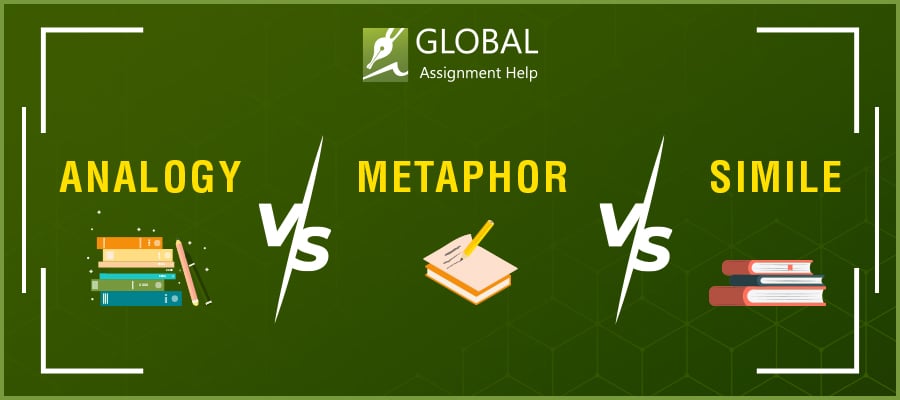Analogy vs Metaphor vs Simile: Meaning, Use-case, and Examples
26 Aug 2024 722 13 minutes
Are you struggling with the analogy vs metaphor vs simile? You often hear them in your literature classes but are unaware of what they mean. In simple terms, they are a literary device used to compare two subjects. But what are these literary devices? They are a way of expressing information or a message in an interesting way to persuade or engage the reader. They are of many types, like oxymoron, simile, metonymy, or metaphor.
Moreover, literary devices are used for the readers to create a vivid image of the information or idea shared, to make it stick in their minds. Now that you know the basic meaning of the literary devices, it is time to learn about metaphor vs analogy vs simile. So, in the blog, their meaning, use cases, examples, and difference is covered. So, without wasting any time, let us begin.
What Is a Metaphor? Example and Uses
If we have to define metaphor, it would be a literary device to compare two things for a rhetorical effect. The comparison between the two subjects is not literal but vivid imagery. Moreover, you write a metaphor concisely, in one or two lines, to build an emotional connection with the readers. You will find metaphors everywhere, from the erudite literature to everyday life. You will get more understanding by reading the example below.
Get Your Assignment DoneExample: “All the world’s a stage, And all the men and women merely players.”
Explanation: It is a common metaphor given by William Shakespeare, in which he is comparing the world to a stage, and all the men on the planet are merely actors or players. The similarity is not literal but rhetorical.
Uses of the Metaphors
Explain Abstract Concepts
Metaphor explains the abstract concepts of the fiction. It means metaphor works best for comparing two subjects of a story, as it creates in the image in the minds of the audience. Moreover, it works best in fiction, as it explains the concept without distracting the readers from the story and connects them emotionally. So, metaphors are a great way to explain difficult things easily.
Create a Sense of Familiarity
Metaphors also help to state familiarity with the concepts or information with the things, readers know. It helps the audience to understand the message better. For instance, “Mr Jake enters the class, a bull chasing thirty-two flags. Here, you will know that someone angry and powerful has entered because of comparison.
Trigger Emotions in People
Another use-case of metaphors is that they trigger emotions in the people. That is why it is best when used for sharing ideas of fiction. If chosen between analogy vs metaphor, the latter works better to convey emotions. For instance, in the above example, you can feel fear of an angry teacher entering the class.
Helps in Visualization
Metaphors create the image of the information or the idea shared in the minds of the readers. It is because a metaphor boils down to imagery. Moreover, if you read a phrase or a metaphor, you can easily create the visuals of the message, as it is written in that way only. As you can see in the above examples, you can imagine the teacher and humans as players.
It is all about the metaphors. Now is the time to read about analogies. But if you are also less skilled in the grammar rules and need it for your assignment, you can read How to Improve Grammar? to learn how to make it perfect.
What Is an Analogy? Example and Uses
Now, let us talk about analogy, which is very similar to metaphors and similes and is used to compare two things. But the difference between metaphor and analogy is that you explain things in depth in analogy, which makes it more complex. In analogy, you compare opposite or unlike subjects by presenting a direct logical argument. It is a great way to explain an idea by comparing it with something else. You will get more understanding by reading the example below.
Example: What you are doing is as important as rearranging the deck chairs on the Titanic.
Explanation: In the above example, you can understand that someone is doing useless work, and it is said by comparing it with the rearrangement of chairs on Titanic.
Uses of Analogy
Explain Abstract Concepts
Explain the unfamiliar abstract concepts to the reader by comparing them with something that it might know. Analogies are best to explain concepts of fiction without taking the audience away from the story. Also, it uses imagery and familiar terms to solidify the idea for the readers.
Helps in Visualizations
Using analogies, you can create an image of the ideas you want to share in the minds of the readers. For instance, explaining a joke is like dissecting the frog, which you grasp better, but the frog dies in the process. Here, you understand that explaining a joke kills its fun by imagining the dissection of a frog.
Trigger Logical Conclusion
Analogies are best at concisely presenting logical conclusions. Fiction writers use it to convey ideas of their story, while non-fiction writers use it to explain their points to the reader. Moreover, speech writers use analogies to express their opinions quickly, without any long explanation, to avoid losing the attention of the audience. It is all about analogies. Let us now move to the simile. But just like you are facing issues with literary devices, you are also stuck on the grammar of your assignment and do not know how to use online tools. You can read How Students Should Use Grammar Checker to Learn Writing.
What Is a Simile? Example and Use
Now, let us talk about simile. If we have to define it, it is one of the figures of speech used to establish a comparison between two subjects using Like and As. If the metaphor says ‘time is a thief’, simile would say ‘time is like a thief’. Moreover, metaphor is a big umbrella, and simile is its sub-category. Further, if you are using simile, it provides a direct comparison to the reader than analogy and metaphor. You will get a deeper understanding by reading the example below.
Example: Life is like a marathon, long and with huddles.
Explanation: Here, life is compared to a marathon, using like. Here, you can clearly understand how the similarities between the two subjects.
Uses of Simile
Explain Abstract Concepts
Metaphor simile analogy explains abstract concepts. You can express your idea or information using a simile by establishing a comparison between two subjects. For instance, if you want to say living a life is difficult, you can use a simile to do it ‘Life is like riding a bicycle, to keep your balance, you must keep moving’.
Provides Clarity to Readers
If you are using similes to express your idea to the readers, they easily understand your explanation. A simile is a better way to express your information than a metaphor or analogy. It is because, in simile, you are using like and as to explain your idea, which provides clarity to the audience about your point and the comparison.
Creates a Vivid Imagery
Simile becomes a great way to create vivid imagery in the minds of the reader. So, if you use it to express your information or idea to the readers, they will easily imagine and understand it better. Moreover, similes provide a stronger description than using adjectives or giving exact details about the point. That is why similes are used everywhere, from day-to-day conversations to poetries. So, it is all about the similes. Now, let us move to the comparison between metaphor, similes, and analogy.
Analogy Vs Metaphor Vs Simile
Let us understand what is the difference between simile, metaphor, and analogy. Knowing it will help you use them effectively. Further, you would know which to use in what situation. But understanding them is not enough to make your work perfect you need to correct your spelling, which you can do by using a grammar checker.
|
Metaphor |
Analogy |
Simile |
|
Uses Like and As |
Do not use Like and As |
Only use like and as |
|
Used in fiction and non-fiction. |
Used to explain abstract concepts and ideas of the story. |
Used to compare two subjects in stories. |
|
Provides a rhetorical comparison. |
Provides comparison of more complex ideas. |
Provides a direct comparison between two things. |
|
Metaphors are artistic and poetic in nature. |
Analogies are explanatory and formal in nature. |
Similes are comparative but easy to understand. |
|
Used to say one thing is similar to the other. |
Used to deliver logical conclusions. |
Used to make your point more interesting. |
So, it is all about metaphor vs simile vs analogy. But if it sounds complex, you can get the aid of experts to do your assignment, and the next section deals exactly with that.
Get Help in Writing Your Homework
It is all about analogy vs metaphor vs simile. The blog first discusses each in detail, like meaning, examples, and uses. It will help you to know the basics of each comparative language tool. You will grasp their definition and purpose. Then, you read their examples, which will solidify your understanding. Finally, you learn the difference between the three. But if all these sound complex, you can get expert aid to do your work by searching for English assignment help. The experts are masters of the three poetic devices and will deliver you quality work using them.
Free Tools

Paraphrasing Checker Tool
Easy to Use Paraphrasing Tool to Simplify Complex Academic Writing
Check Now
Dissertation Outline Generator
Get Structured Outline by Professionals for Your Dissertation
Check Now
Referencing Tool
Effortlessly manage citations and references with our smart referencing tool
Check NowLowest Price Guarantee
Get A+ Within Your Budget!Price Calculator
Offers & Benefits
Get upto 56% OFF on Your First Order !
Offers Benefits
Other Services
Latest Blogs

- 20 Mar 2025
- 556 Views

- 04 Mar 2025
- 480 Views

- 28 Feb 2025
- 562 Views

- 25 Feb 2025
- 329 Views



















Thank you for submitting your comment on this blog. It is under approval. We will carefully review your submission and post it on the website.